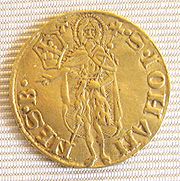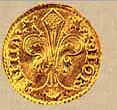
Italian coin florin
Encyclopedia


Italy
Italy , officially the Italian Republic languages]] under the European Charter for Regional or Minority Languages. In each of these, Italy's official name is as follows:;;;;;;;;), is a unitary parliamentary republic in South-Central Europe. To the north it borders France, Switzerland, Austria and...
florin was a coin
Coin
A coin is a piece of hard material that is standardized in weight, is produced in large quantities in order to facilitate trade, and primarily can be used as a legal tender token for commerce in the designated country, region, or territory....
struck from 1252 to 1533 with no significant change in its design or metal content standard. It had 54 grains
Grain (measure)
A grain is a unit of measurement of mass that is nominally based upon the mass of a single seed of a cereal. From the Bronze Age into the Renaissance the average masses of wheat and barley grains were part of the legal definition of units of mass. However, there is no evidence of any country ever...
of nominally pure ('fine') gold (3.5g, 0.1125 troy ounce
Troy ounce
The troy ounce is a unit of imperial measure. In the present day it is most commonly used to gauge the weight of precious metals. One troy ounce is nowadays defined as exactly 0.0311034768 kg = 31.1034768 g. There are approximately 32.1507466 troy oz in 1 kg...
) worth approximately 200 modern US Dollars. The "fiorino d'oro" of the Republic of Florence
Republic of Florence
The Republic of Florence , or the Florentine Republic, was a city-state that was centered on the city of Florence, located in modern Tuscany, Italy. The republic was founded in 1115, when the Florentine people rebelled against the Margraviate of Tuscany upon Margravine Matilda's death. The...
was the first Europe
Europe
Europe is, by convention, one of the world's seven continents. Comprising the westernmost peninsula of Eurasia, Europe is generally 'divided' from Asia to its east by the watershed divides of the Ural and Caucasus Mountains, the Ural River, the Caspian and Black Seas, and the waterways connecting...
an gold coin struck in sufficient quantities to play a significant commercial role since the seventh century. As many Florentine banks were international supercompanies with branches across Europe, the florin quickly became the dominant trade coin of Western Europe for large scale transactions, replacing silver bars in multiples of the mark (a weight unit
Units of measurement
A unit of measurement is a definite magnitude of a physical quantity, defined and adopted by convention and/or by law, that is used as a standard for measurement of the same physical quantity. Any other value of the physical quantity can be expressed as a simple multiple of the unit of...
equal to eight troy ounce
Troy ounce
The troy ounce is a unit of imperial measure. In the present day it is most commonly used to gauge the weight of precious metals. One troy ounce is nowadays defined as exactly 0.0311034768 kg = 31.1034768 g. There are approximately 32.1507466 troy oz in 1 kg...
s).
In the fourteenth century, a hundred and fifty European states and local coin issuing authorities made their own copies of the florin. The most important of these was the Hungarian forint
Hungarian forint
The forint is the currency of Hungary. It is divided into 100 fillér, although fillér coins are no longer in circulation. The introduction of the forint on 1 August 1946 was a crucial step of the post-WWII stabilization of the Hungarian economy, and the currency remained relatively stable until...
because the Kingdom of Hungary
Kingdom of Hungary
The Kingdom of Hungary comprised present-day Hungary, Slovakia and Croatia , Transylvania , Carpatho Ruthenia , Vojvodina , Burgenland , and other smaller territories surrounding present-day Hungary's borders...
was a major source of gold mined in Europe (until the New World
New World
The New World is one of the names used for the Western Hemisphere, specifically America and sometimes Oceania . The term originated in the late 15th century, when America had been recently discovered by European explorers, expanding the geographical horizon of the people of the European middle...
began to contribute to the supply in the sixteenth and seventeenth centuries, most of the gold used in Europe came from Africa
Africa
Africa is the world's second largest and second most populous continent, after Asia. At about 30.2 million km² including adjacent islands, it covers 6% of the Earth's total surface area and 20.4% of the total land area...
).
The design of the original Florentine florins was the distinctive fleur de lis badge of the city on one side and on the other a standing facing figure of St. John the Baptist
John the Baptist
John the Baptist was an itinerant preacher and a major religious figure mentioned in the Canonical gospels. He is described in the Gospel of Luke as a relative of Jesus, who led a movement of baptism at the Jordan River...
wearing a hair shirt. On other countries' florins, first the inscriptions were changed (from "Florentia" around the fleur, and the name of the saint on the other), then local heraldic
Heraldry
Heraldry is the profession, study, or art of creating, granting, and blazoning arms and ruling on questions of rank or protocol, as exercised by an officer of arms. Heraldry comes from Anglo-Norman herald, from the Germanic compound harja-waldaz, "army commander"...
devices were substituted for the fleur de lis.

The weight of the original fiorino d'oro of Florence was chosen to equal the value of one lira
Lira
Lira is the name of the monetary unit of a number of countries, as well as the former currency of Italy, Malta, San Marino and the Vatican City and Israel. The term originates from the value of a Troy pound of high purity silver. The libra was the basis of the monetary system of the Roman Empire...
(i.e. a nominal pound of 240 inflated denari) in the local money of account
Coin of account
A coin of account is a unit of money that does not exist as an actual coin but is used in figuring prices or other amounts of money. For example, the mill is a coin of account in the United States...
in 1252. However, the gold content of the florin did not change while the money of account continued to inflate
Inflation
In economics, inflation is a rise in the general level of prices of goods and services in an economy over a period of time.When the general price level rises, each unit of currency buys fewer goods and services. Consequently, inflation also reflects an erosion in the purchasing power of money – a...
; by 1500, a florin was worth seven Florentine lire. The values of other countries' money continually varied against each other, reinforcing the florin's utility as a common measure of value for foreign exchange transactions.
Rheingulden
A regional variant of the florin was the Rheingulden, minted by several German states encompassing the commercial centers of the Rhein (Rhine) River valley, under a series of monetary conventions starting in 1354, initially at a standard practically identical to the Florentine florin (98% gold, 3.54 grams). By 1419, the weight had been slightly reduced (to 3.51 grams) but the alloy was substantially reduced (to 79% gold). By 1626, the alloy had been further slightly reduced (to 77% gold), while the weight was more substantially reduced (to 3.24 grams). In 1409, the Rheingulden standard (by then 91.7% gold) was adopted for the Holy Roman Empire's Reichsgulden.
Sources
- http://www.gmmnut.com/gmm/sca/florin.html - See Discussion
- The Economy of Renaissance. Florence. Richard A. Goldthwaite http://books.google.it/books?id=OM2ckx49QFYC&pg=PT71&lpg=PT71&dq=gold+florin+florence+coin&source=bl&ots=X5kMKAlaEh&sig=rgsRw-d0xc417YyZHGhRQBBCaIQ&hl=it&ei=SZNNS7aPMciN_Aav9KWgDg&sa=X&oi=book_result&ct=result&resnum=6&ved=0CCoQ6AEwBTgK#v=onepage&q=gold%20florin%20florence%20coin&f=false
- http://www3.telus.net/Quattrocento_Florence/economy.html BROKEN as of Feb 2011

